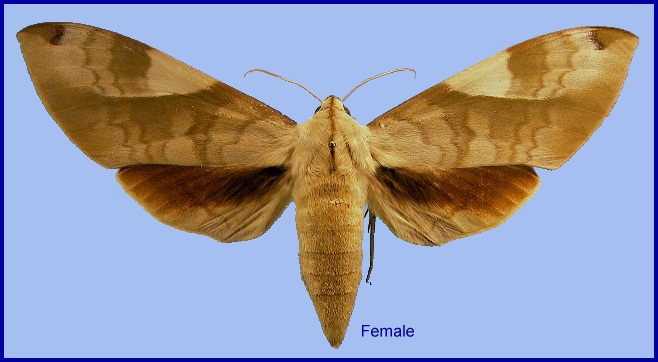
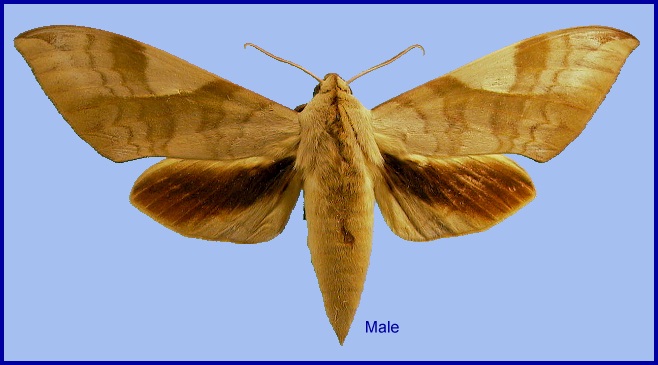
Clanis bilineata tsingtauica Mell, 1922, Beitr. Fauna Sinica 2: (Biol. Syst. südchin. Sphingiden): 114. Type locality: China, [Shandong,] Tsingtau [Qingdao].
Note. Up until recently, three poorly differentiated subspecies were recognized; these have now been synonymized (see below). The more heavily marked Clanis bilineata tsingtauica Mell, 1922, occurs in Japan and northern China as far south as Shaanxi and Zhejiang. The more lightly marked nominotypical subspecies, Clanis bilineata bilineata (Walker, 1856), has been recorded from Sichuan and Guangdong, from where it extends west to Nepal and south to southern India, Thailand and Vietnam. The status of the intervening Chinese populations from Hubei, Hunan, Jiangxi and Fujian remain to be ascertained (Pittaway and Kitching, 2000). The population on Taiwan is Clanis bilineata formosana Gehlen, 1941 (Lin, 1989).
Note. As this is quite a variable species with regard to wing patterning and DNA barcodes, with these having no apparent habitus or geographical correlation, Eitschberger, 2004, Neue ent. Nachr. 58: 79-80 synonymized all subspecies with the nominotypical subspecies.
Note. There are several similar species of Clanis. In Clanis undulosa Moore, 1879, the mid-tibiae are black when viewed from above, and the spurs are longer. Clanis phalaris (Cramer, 1777) lacks the dark basal patch on the hindwings. Clanis deucalion (Walker, 1856) has three distinct rows of small grey crescents across the discal area, forming wavy bands.
[Further details on this species in Japan, as well as photos of many stages, can be found on Digital Moths of Japan as well as Moths of the southern Shikoku, Japan.]
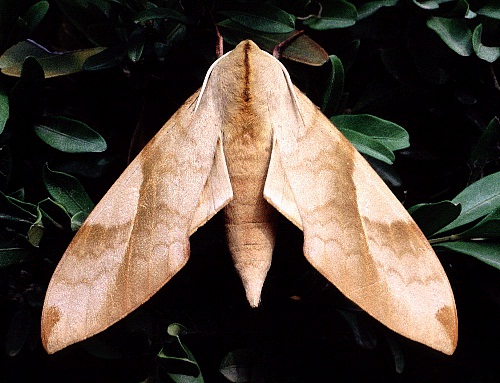
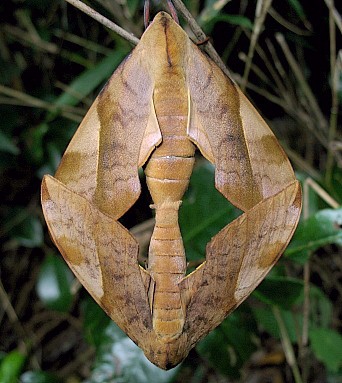
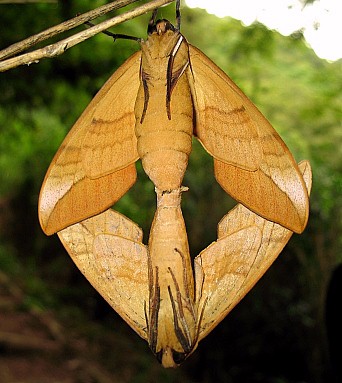
Wingspan 94--120mm. The uppersides vary in basic colour from reddish-brown to greyish-brown. On the forewings there are several darker areas, two of which enclose a distinct clear triangular discal area in from the costa. The base of this area is slightly but smoothly curved. The hindwings are a darker reddish-brown with a dark grey or black basal patch. Both sets of wings may be crossed with several distinct oblique rows of small grey crescents, forming wavy bands. There is always a dark brown apico-costal triangle at the tip of the falcate forewing. The legs, especially the mid-tibiae, are white.
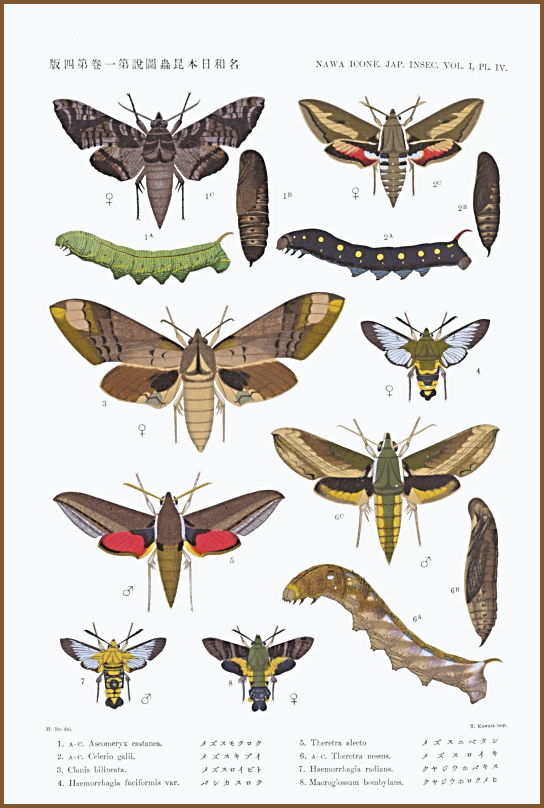
A very adaptable species found in open forests, forest edge, cultivated landscapes, scrub and suburban gardens.
This species flies late at night, usually after 01.00 hours and until daybreak (Tennent, 1992). It is readily attracted to light, often in large numbers. Pairing lasts for only 3-4 hours.
Each female lays between 200 and 450 eggs (average 350) over 3 days on the underside of leaves. These hatch 6-8 days later (Xiao et al., 1991).
China: vi (Liaoning; Jilin), 2.vii (Zhejiang); 17-20.vii (Shaanxi; Liaoning); 18.viii (Anhui); 30.viii (Zhejiang); ix (Shaanxi; Zhejiang). South Korea: 20-28.vi (Ulleung-do); 8.vii [(unstated locality)]; 31.vii (Ori-Dong). Japan: 2.iv (Hokkaido); 20.vi (Hajichoshima); vii (Tsushima; Hokkaido); 14.vii (Shikoku); vii-x (Honshu); 5-17.viii (Hokkaido). Russia: 6.ix (Primorskiy Krai).
In northern China (north of 32°N), there is only a single generation per year, with adults on the wing between June and August (Yang, 1978). South of 31°N there are two or more generations between April and November (Chu et al., 1979; Tennent, 1992).
Park et al. (1999) give mid May until late September as the flight period in Korea.
The single record and late date of capture for Primorskiy Krai indicate that this species is a late summer vagrant to the Russian Far East.
OVUM: Pale green, oval (2.30 x 2.77mm), shiny and smooth (Bell and Scott, 1937).
LARVA: Full-fed 80--100mm. In the final instar the large, round, yellow-tubercled head is glaucous-green with dark brown eyes, a diffuse white labrum, white and brown antennae and pinkish mandibles. The slender and cylindrical body is dull grass-green with a transverse row of small yellow tubercles around each secondary segment ring. There is a dorso-lateral line of larger tubercles from thoracic segment 2 to abdominal segment 1, and seven oblique lateral stripes of similar tubercles on abdominal segments 2 through 8 (Xiao et al., 1991). The short (6mm), well developed, yellow-tubercled green horn is thick at its base but tapers sharply to a blunt point. The large, oval spiracles are yellowish-green (Bell and Scott, 1937; Nakatomi, 1987).
The larvae prefer younger leaves, often stripping growing shoots, particularly in the final instar. In heavy infestation, entire plants may be defoliated.
On trees, the full-grown larvae are usually found resting right at the end of branches 3-6m from the ground (Bell and Scott, 1937). On soyabean, the light-sensitive larvae change position frequently, usually at night, when most feeding takes place. This stage lasts about 39 days (Xiao et al., 1991).
The larva are utilized in China as an animal feed additive and human food source, and can be bought freeze-dried, fried, fresh, canned or powdered at food/feed product markets. In Jiangsu Province and adjacent areas, the larvae are esteemed as a culinary delicacy (Li et al., 2024). In fact, this traditional edible insect has long been known for its high nutritional value in East Asia. Live larvae have also been shown to be promising alternative hosts for Chinese caterpillar fungus (Cordyceps and Ophiocordyceps species), a traditional Chinese medicine (Gao, Zhao, Xu & Shi, 2021).
When testing different larval hosts, Li et al. (2024) found that round-leaf soyabean gave the best larval performance, indicating its potential for improving larval production and sustainability in production systems.
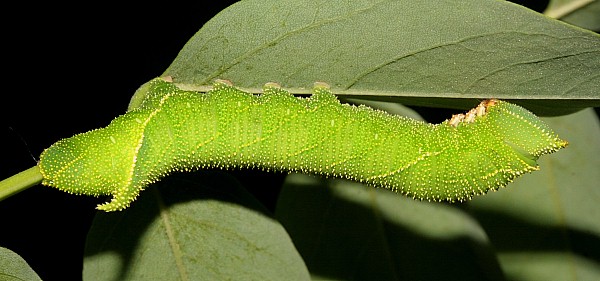
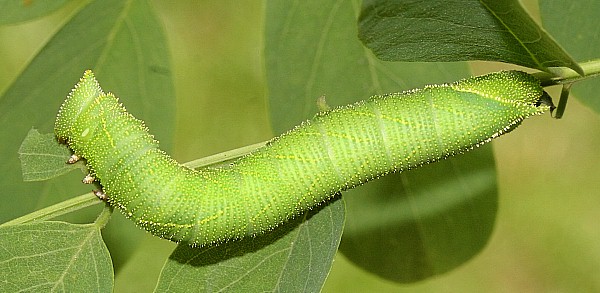
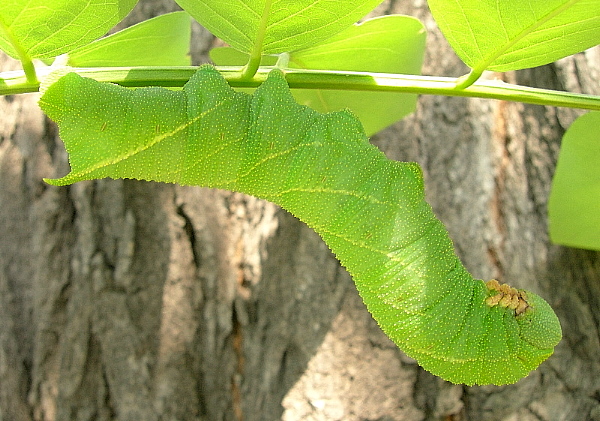
PUPA: 50--60mm. Rich, glossy, pale mahogany-brown with bevels of movable abdominal segments paler; spiracles and cremaster black. The length of the front of the pupa to the end of the wing-cases is more than the rest of the pupa. There are pronounced antespiracular ridges on abdominal segments 6 through 8. The very rugose cremaster is wedge-shaped and upturned (Bell and Scott, 1937).
Larval hostplants. Monophagous in China on Fabaceae, including Acacia, Glycine, Mucuna, Puereria and Robinia (Mell, 1922b; Yang, 1978; Chu et al., 1979; Wang, 1992; Ren et al. 1993). Clanis bilineata tsingtauica has benefitted greatly from the introduction and widespread establishment in China of the North American tree, Robinia pseudoacacia. Wang (1992) also listed Olea (Oleaceae) and Paulownia (Scrophulariaceae) but these are almost certainly erroneous. The record on Daemonorops margarithae (Arecaceae) (Chang, 1989) is an erroneous interpretation of Mucuna pruriens, with which it shares the same Chinese common name.
This species was, and still is, a major pest of soyabeans (Glycine max) in China, often defoliating entire fields (Xiao et al., 1991; Ren, Chen and Wan, 1993).
Recorded in Korea from Lespedeza cyrtobotrya, Lespedeza bicolor var. japonica and the introduced Robinia pseudoacacia (Park et al., 1999).
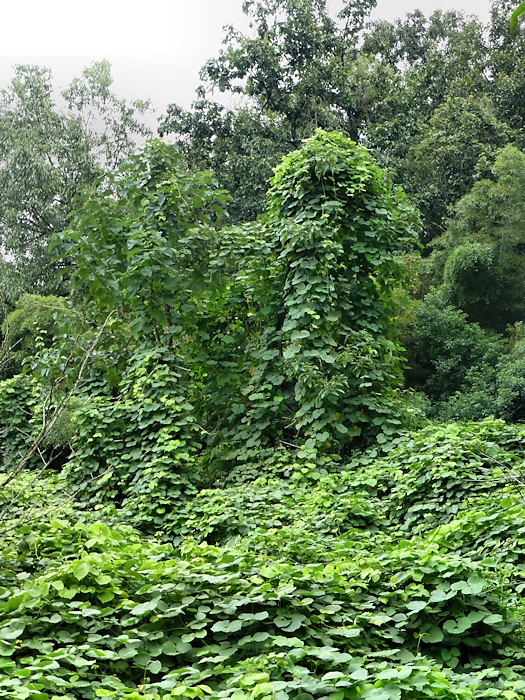
Trichogrammatidae: Trichogramma chilonis Ishii, 1941 [syn. Trichogramma confusum Viggiani, 1976]; Trichogramma dendrolimi Matsumura, 1926; Trichogramma closterae Pang & Chen, 1974. Scelionidae: Telenomus lebedae Chen & Tong, 1980; Telenomus tetratomus Kieffer, 1906; Telenomus angustatus (Thomson, 1861). Tachinidae: Exorista bombycis (Louis, 1880).
China: Jilin (Jiaohe, Lafa Shan); Liaoning (Dalian; Changhai, Dachangshan Island); Hebei; Beijing (Botanical Garden); Tianjin; Shandong (Qingdao; Weihai; Yantai); Shanxi (Taiyuan; Taigu; Qixian; Yuci; Pingyao; Wenshui; Jiexiu; Xinzhou; Shouyang; Heshun; Zuoquan; Xiyan); Shaanxi (Yangling; Louguantai Forest Park; Xunyang, 1380m); Gansu (Daxingying Village); Jiangsu (Nanjing); Anhui (Mt. Huang Shan; Jiuhua Shan; Huaibei); Zhejiang (Tianmu Shan; Kuocang Mountain Nature Reserve); Hubei (Badong); Shanghai.
North Korea: South Pyongan Province (Pyongyang); Kangwondo Province (Keumgang-san); South Hamgyong Province (Seokwang Temple; Gyungsung); North Hamgyong Province (Jueul).
South Korea: Baengnyeong-do & Daecheong-do; Seoul; Kyonggi Province; Kangwon Province; North Chungchong Province; South Chungchong Province; North Cholla Province; South Cholla Province; North Kyongsang Province (Ulleung-do); South Kyongsang Province; Cheju Province
Japan: Hokkaido (Mori Himekawa); Hajichoshima (Sokodo); Honshu (Tokyo; Kyoto; Takayama; Nashimoto; Mikaboyama; Fujisawa; Iruma; Akashina; Oki Islands; Asagiri-kogen); Shikoku (Niyodogawa); Tsushima (Sasuna); Kyushu (Nagasaki); Ryukyu Archipelago (Okinawa).
Russia: Primorskiy Krai (Khasan; Narva; Jankowski Peninsula; Primorskiy).
This subspecies occurs in the Russian Far East (rare), Japan, Korea and northeastern China, as far south as Shaanxi and Zhejiang.
Records from other parts of South East Asia are erroneous, the result of confusion with other species.
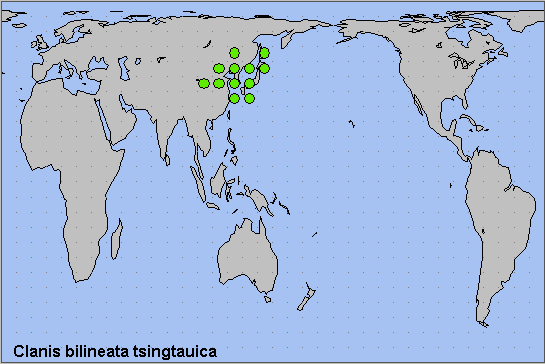
Holarctic and Oriental; eastern Palaearctic and Oriental regions. Pleistocene refuge: Unknown.
 Return to Sphingidae of the Eastern Palaearctic species list
Return to Sphingidae of the Eastern Palaearctic species list